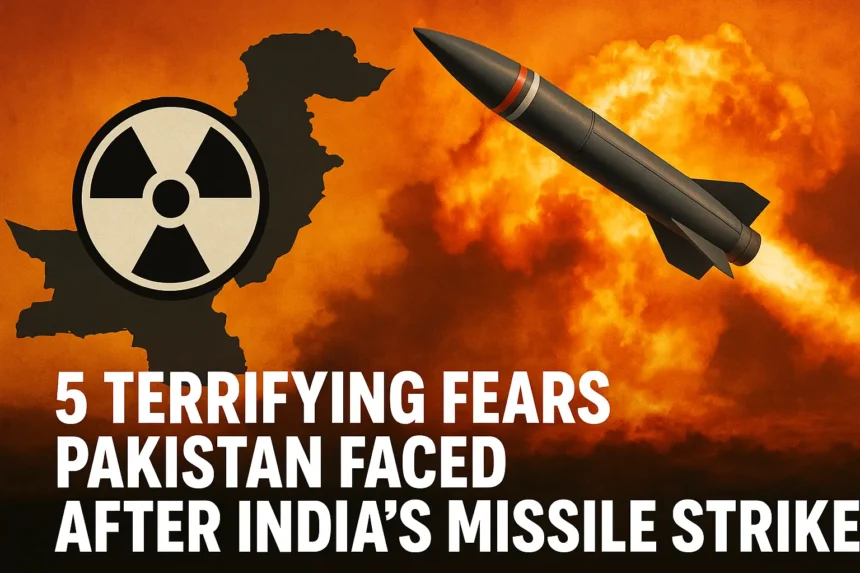How Close Was Pakistan to Nuclear Chaos After India’s Strike?
The uneasy peace between India and Pakistan has long stood on a razor’s edge—but on May 10, that edge came dangerously close to snapping. When India launched a precision missile strike on Pakistan’s Noor Khan Airbase, it didn’t just damage infrastructure—it ignited fears of something far more chilling: a nuclear unraveling.
A report by the New York Times revealed that senior officials in Islamabad were deeply concerned that India might be planning a direct attack on Pakistan’s nuclear command system. Such an attack could potentially disable Pakistan’s ability to respond with nuclear weapons. Their concern grew even more serious because the Noor Khan Airbase, which was targeted, is located very close to the Strategic Plans Division—the main center that oversees Pakistan’s nuclear arsenal. This raised fears that the situation could quickly escalate into a much larger and more dangerous conflict.
In the hours that followed, global capitals from Washington to Riyadh watched in alarm, as the world edged toward a crisis with unthinkable consequences.
So what triggered this terrifying moment? Why did Pakistan fear a nuclear blackout? And how close did we come to disaster? Let’s break down the attack, the intelligence fears, and the international response that barely held the region back from the brink.
1. India’s Precise Missile Strike Raises Alarms
To better understand the significance of the May 10 strike and its potential implications, here’s a quick breakdown of the key facts surrounding the attack on Noor Khan Airbase and its proximity to Pakistan’s nuclear command infrastructure:
| Date of Attack | May 10, 2025 |
| Location | Noor Khan Airbase, Rawalpindi |
| Type of Strike | Precision Missile Attack |
| Damage Reported | Significant Structural Damage |
| Proximity to SPD | Very Close – Nuclear Command at Risk |
| Strategic Concern | Potential Threat to Nuclear Control Systems |
2. Pakistan’s Fear of a Nuclear Command ‘Decapitation’
According to a U.S. official quoted by the New York Times, Pakistan’s biggest fear after the strike wasn’t the immediate physical damage—it was the message behind it. Intelligence discussions began revolving around the term “decapitation strike”—a strategy aimed at disabling Pakistan’s nuclear command and control system.
Pakistan worried that India’s true objective might be to cripple its ability to launch a nuclear response by targeting its leadership nodes, communication systems, and even nuclear storage sites. Many of these high-value assets are located in and around Rawalpindi and Islamabad, making the strike on Noor Khan Airbase all the more alarming.
3. Nuclear Warhead Security Became Top Priority
With an estimated 170 nuclear warheads, Pakistan has always maintained a veil of secrecy over its nuclear infrastructure. But following the May 10 strike, defense forces were placed on red alert. Fighter jets scrambled, missile defense systems activated, and multiple assets were relocated to undisclosed locations.
Pakistan’s Strategic Plans Division, headquartered near the airbase, suddenly found itself under intense scrutiny. Were the nukes safe? Was the command intact? These questions echoed not just in Islamabad, but in Washington, Riyadh, and New Delhi.
4. U.S. and Gulf Nations Step in to Ease Tensions
As tensions escalated, the situation drew rapid international attention. The following table highlights key diplomatic actions and reactions that unfolded in the aftermath of the strike:
| Key Mediators | United States and Gulf Countries |
| US Action | Privately urged both sides to show restraint |
| Pakistan’s Response | PM Shahbaz Sharif publicly thanked the US |
| India’s Response | Denied any foreign mediation or pressure |
| Implication | Revealed the fragility of peace in South Asia |
| Risk Level | High – Nuclear escalation was a real threat |
5. India’s Message: “We Will Strike Where It Hurts Most”
Though India officially maintained strategic ambiguity over the Noor Khan airstrike, the intent was unmistakable—and loud. The operation was a direct message to Pakistan and the world: India, under Prime Minister Narendra Modi’s decisive leadership, will not hesitate to act with precision and power when its sovereignty is challenged.
By targeting a base near Pakistan’s nuclear infrastructure, deep within the fortified city of Rawalpindi, India showcased not only superior intelligence but also its unflinching resolve to breach even the most guarded zones. This was not just a warning—it was a declaration of strategic dominance.
The shockwaves were felt across Pakistan’s security establishment. Intelligence agencies reportedly feared that Islamabad itself could be next—forcing a hurried overhaul of air defense systems and triggering high-level crisis management protocols.
Under PM Modi, India has made it abundantly clear: Any provocation will be met with a response that is swift, sharp, and unforgettable.
What This Means for Regional Stability
This dramatic episode has left a lasting impact on both nations’ strategic planning. Pakistan has likely beefed up the security of its nuclear facilities, and India has shown it won’t hesitate to cross conventional red lines when necessary.
The situation also emphasized the importance of rapid diplomatic communication between the two nuclear-armed neighbors. As both countries continue to modernize their arsenals, risk mitigation will be key to avoiding future confrontations that could spiral out of control.
Final Thoughts: Walking the Nuclear Tightrope
This is not the first time India and Pakistan have come to the brink of war—but rarely has the threat felt so intimate, so imminent. The fear of a nuclear command strike is no longer hypothetical.
The May 10 attack has changed how military planners in both nations will approach future conflicts. The line between conventional and nuclear warfare has blurred, and the world is watching more closely than ever.
If you’re concerned about global security and nuclear threats, follow our coverage for in-depth updates and expert analysis. Bookmark this page, share it with friends, and explore our latest stories on South Asian geopolitics, nuclear deterrence, and international diplomacy.
Most read: https://tnheadlines24.com/chinas-big-loss/
Disclaimer: This article is based on publicly available news reports, including sources like the New York Times, and includes analysis for informational purposes only. The views expressed do not necessarily reflect those of TN HEADLINES24. TN HEADLINES24 is not responsible for any interpretation, assumptions, or consequences arising from the information provided in this article. Readers are advised to verify facts independently and consider official sources for critical updates.




